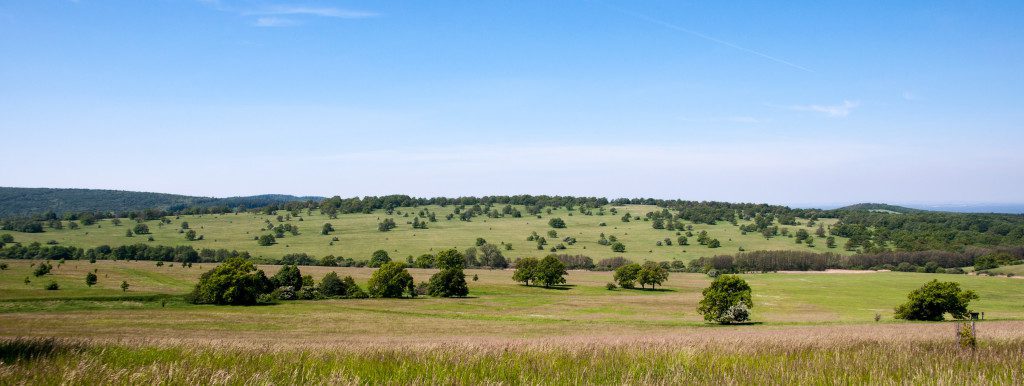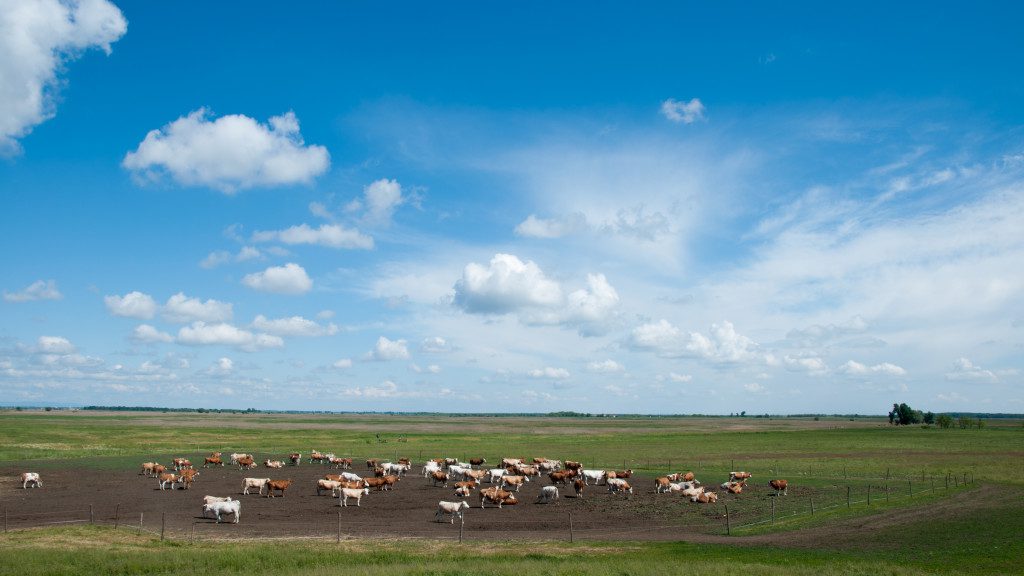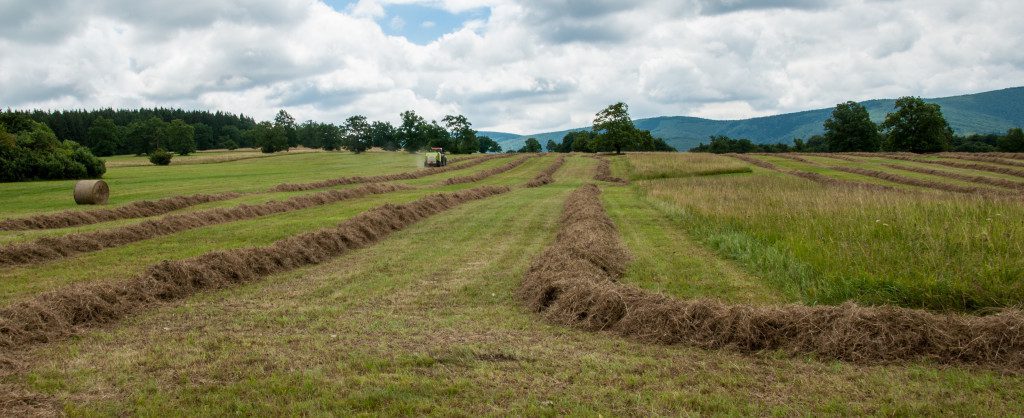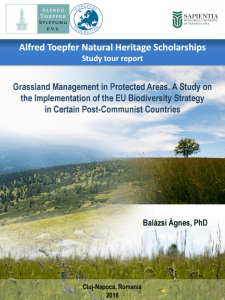Biodiversity and Health in the Face of Climate Change – Conference
Biodiversity and Health in the Face of Climate Change
Challenges, opportunities and evidence gaps
27-29 June 2017, Bonn/Germany
European Conference hosted by the German Federal Agency for Nature Conservation (BfN) and the European Network of Heads of Nature Conservation Agencies (ENCA) in co-operation with the Helmholtz-Centre for Environmental Research (UFZ) / German Centre for Integrative Biodiversity Research (iDiv)
Climate change poses significant challenges to biodiversity and human well-being in Europe. As the majority of Europeans live in urban areas and cities are often subject to exacerbated heat island effects, consequences of climate change may be experienced first in urban settings. Biodiversity in urban as well as in adjacent rural areas, in turn, can provide health and climate change mitigation and adaptation benefits that can be actively fostered by nature-based solutions.
This joint European conference in Bonn will bring together experts from science, policy and practice to highlight and discuss the importance of biodiversity’s contribution to human health in the face of climate change. In this context health is considered in its physical, psychological and social dimension, including socio-environmental equity. The aim of the conference is to increase knowledge, share experiences and foster nature-based solutions to meet the challenges of climate change and health issues.
The conference is divided into three main areas (day 1: science, day 2: practice and implementation, day 3: policy and economy) and will feature presentations by leading experts in the fields of biodiversity, health and climate change including:
– Humberto Delgado Rosa (European Commission, DG Environment, Director for Natural Capital)
– Hans Bruyninckx (Executive Director European Environmental Agency, EEA) tbc
– Cristina Romanelli (Secretariat of the Convention on Biological Diversity, CBD) tbc
– Thomas Elmqvist (Stockholm Resilience Centre)
– Richard Mitchell (Institute for Health and Wellbeing/CRESH, Glasgow University)
– Kevin Gaston (University of Exeter, UK)
– Terry Hartig (Upsala University, Sweden)
– Catherine Ward Thompson (Edinburgh College of Art, UK)
– Roderick Lawrence (Director of the Global Environmental Policy Program, University Geneva)
– Thomas Claßen (NRW Centre for Health, Germany)
– Karsten Mankowsky (Political chair of the German National Healthy Cities Network)
– Chantal van Ham (IUCN) tbc
On day 2, interactive workshop sessions will address eight specific themes ranging from “Evidence for biodiversity’s contribution to health”, to “Health and protected areas” and “Psychological effects of nature and biodiversity” as well as “Linking initiatives in biodiversity, health and policy”, “Allergenic plants and vector borne diseases” and “Nature-based solutions for health and social equity”. In addition, “Landscape planning for multifunctional urban spaces” will be addressed. A special session is dedicated to “Lessons learned from green interventions for enhancing human health in urban areas”, where emphasis is given to good practice examples and the sharing of experience among community level actors.
Results of conference discussions will feed into ENCA recommendations for creating synergies between ongoing policy processes, scientific programmes and practical implementation of nature conservation measures in European urban and rural areas to support health measures in the face of a changing climate.
Here, you will find information on the conference programme and interactive sessions.
Networking opportunities and social events include an evening reception and a conference dinner.
Open abstract call for talks & posters
Abstracts and oral and poster presentations are welcomed! Oral presentations will be held within the eight interactive sessions. They are focused on contributions that demonstrate good practice in implementing nature-based solutions to health and equity issues in urban areas and their rural surroundings from a scientific, policy and practical perspective. Ideally these topics should be linked to climate change issues. Please notice that only a limited number of contributions can be accepted.
The themes are:
- Biodiversity or green space? Evidence for contributions to health in a changing climate
- Health and protected areas in a changing climate
- Psychological effects of nature and biodiversity on human health and well-being
- The benefits of green space for enhancing human health – lessons learned from urban interventions
- Linking Initiatives in biodiversity, health and climate change action in policy and practice
- Allergenic plants and vector borne disease – relevance to human health in a changing climate
- Nature-based solutions for climate change adaptation and their role in fostering health and socio-environmental equity
- Planning and managing urban green spaces for health and biodiversity in a changing climate – Concepts, experiences, practice
Deadline for abstract submission is Monday, 6 February 2017 (abstract submission guidelines)
Registration
Early bird registration deadline: Monday, 3 April 2017
Final registration deadline: Monday, 29 May 2017
Please register here (Due to limited availability of places early registration is recommended.)
Transboundary Parks Programme on PANORAMA
A new booklet entitled “Solutions in Focus: Transboundary Protected Area Solutions” has just been published by IUCN under the initiative “PANORAMA – Solutions for a Healthy Planet”, coordinated by IUCN and GIZ. In the booklet, you will find 17 solutions that have been implemented by protected area managers addressing conservation and economic challenges in transboundary regions.
Eight of the solutions (see Table below) focus on parks that have been certified through the EUROPARC Transboundary Parks Programme. These were developed in collaboration between protected area professionals and members of the Institute of Silviculture at the University of Natural Resources in Life Sciences, Vienna, Austria (BOKU) (Brady Mattsson and Sophia Fettinger) through the EU funded ForAdapt project.

Transboundary Parks on “PANORAMA – Solutions for a Healthy Planet”
Transboundary Parks Programme on PANORAMA Webinar
One of the EUROPARC certified transboundary regions was also highlighted in an associated PANORAMA webinar “Transboundary Protected Area Solutions”, held on 7 December 2016. You can access the entire webinar recording and all presentations.
Opportunity for Park Staff: international study trips by EUROPARC Germany
Excursion at the Black Forest National Park, within the celebration of the 25th Anniversary of EUROPARC Gerrmany © Stephanie Schubert
Do you work for a protected area as paid or volunteer park staff and are interested in transboundary exchange? EUROPARC Germany is organising 2 study trips in 2017 for park staff about accessibility and tourism development in Protected Areas.
EUROPARC Germany supports professionals and volunteers in European protected areas in exchanging know-how and competencies and in building up international cooperation. The project “international exchange of competencies of players in protected areas” (ANNIKA) focusses on one-week international study trips of approximately six participants – paid and volunteer park staff – that treat the following subjects:
- Education for sustainable development (e.g. Junior Ranger)
- Regional development and sustainable tourism (e.g. touristic partners, voluntourism)
- Inclusion of people with disabilities (e.g. accessibility, volunteers with disabilities)
- Park Management (e.g. quality standards, evaluations)
The overall topic will be volunteer management, i.e. the question “how do we involve volunteers in the activities of parks in a professional way?”.
The program of the study trip consists of lectures, workshops and field trips. They will give you the opportunity to gain insight into best practice examples of the parks visited and to share your experience and knowledge with experts on site. The project aims to give you the unique possibility to learn from each other and to work together on new ideas and strategies. Your protected area will directly benefit from the knowledge and experience you will gain through the study trip. In addition, the study trip enables you to establish a long-term relationship and cooperation with other European parks.
At the end of the project the experiences, lessons learned and outcomes will be summarised by the participants in a bilingual publication and discussed in a conference.
Study Trips in 2017
Grab the opportunity to learn with colleagues from across Europe
In 2017, 2 field trips will be offered:
- “Accessibility and inclusion of people with disabilities in protected areas“, 19.-22. März
- “Regional development and tourism in protected areas”, 14.-18. Mai
Download below the complete programme and the application form for both study trips. The deadline for application is February 2017.
The following study trips have already been organised:
Grassland Management in Protected Areas in Post-Communist Countries
Hay meadow in the White Carpathians, CZ © Balázsi Ágnes
Grassland Management in Protected Areas: A Study on the Implementation of the EU Biodiversity Strategy in Certain Post-Communist Countries
Article issued by Ágnes Balázsi
Every year, the Alfred Toepfer Natural Heritage Scholarship (ATS) supports the work of young conservationist in protected areas across Europe. Ágnes was one of the winners of the Scholarship in 2015.
The EU Biodiversity Strategy 2020 proposed to halt the biodiversity loss and the degradation of ecosystem services in order to fulfil the objectives of the Convention on Biological Diversity. However, no significant overall progress has been achieved in the EU since 2011.
The objective of the study was to gain an overview on the implementation of the EU Biodiversity Strategy, with emphasis on grassland management, in different protected areas from Hungary, Slovakia and the Czech Republic. In 2016, I had the possibility visit 2 protected areas in each country, to gather information about grassland management in protected areas. This was possible through the Natural Heritage scholarship, offered by the Alfred Toepfer Stiftung F.V.S together with the EUROPARC Federation.
The scholarship consisted in:
- (i) a visit to six protected areas’ headquarters and guided field trips on grassland areas;
- (ii) a presentation about the implementation of EU Biodiversity Strategy and data collection
- (iii) interviews/discussions on public administration structure, protected areas’ administration, management plans, monitoring of grassland habitats/species, rewarding systems and collaboration with stakeholders.
The visited protected areas were the Hortobágy National Park (HU), the Bükki National Park (HU), the Low Tatras National Park (SK), the Great Fatra National Park (SK), the Krkonoše Mountains National Park (CZ) and the White Carpathians Protected Landscape Area (CZ).

Cultural landscape in Certoryje (White Carpathians, CZ) with species-rich hay meadows and scattered trees © Balázsi Ágnes
The targeted countries face similar challenges when implementing and harmonising the agricultural and conservation policies nationally, rising from the history of political systems, changes in property rights and land use after the communism and the similar amount of time within the EU.
Different countries, similar history
The political, social, economic and environmental context of the last century has generated complex and synergistic challenges for the actual nature conservation. Livestock changes and farmlands’ reorganisation have the most significant impact on semi-natural grasslands and on traditional farming landscapes.

Cattle grazing on the Puszta, Hortobágy (HU) © Balázsi Ágnes
Whereas, the global environmental preoccupation for the designation of protected areas became a normality in the late 20th century, the top-down governance systems and centralised administrative power created (i) a gap between local communities and authorities and (ii) a formal protection of sites lacking financial support for management, personnel capacity and technical equipment. These gaps were not bridged in all of the cases.
Grassland Management – bridging the gaps
The gaps between public administration, managers of protected areas and stakeholders must be bridged within integrated multilevel governance (e.g. nature conservation and agriculture) instead of a domain-oriented approach (e.g. nature conservation or agriculture).
Effective grassland management requires successful sustainable agricultural practices, that must be developed and adopted to local conditions in order to respond to the reality’s context. In this interaction, protected area managers and nature conservation institutions, along with agriculture have a very important role. The continuous knowledge transfer from research to public administration and between institutions could be a huge advantage making the public administration respond more realistically and flexible to the social-ecological systems’ complexity.

Mosaic mowing (conservation measure) of the hay meadows in the White Carpathians Protected Landscape Area (CZ) © Balázsi Ágnes
The lessons learned from different protected areas have their own specific importance in every country. Successful conservation of nature is not always depending on circumstances but on the willingness of passionate professionals to harmonise their objectives. The active involvement of stakeholders in the governance of protected areas could lead to local initiatives which are stronger than a global political framework and offer a more practical support to achieve or maintain the favourable conservation status of the grassland habitats.
The re-connection of farmers/landowners with their cultural and natural heritage by raising their awareness of the global value of those social-ecological systems could lead to a complex approach and multilevel solutions.
Further comparative case studies might lead to a deeper understanding upon the complexity of the current situation of countries in transition, focusing on the history of political systems, changes in property rights and land use after the communism.
Personally, the Alfred Toepfer Natural Heritage Scholarship offered a unique opportunity to expand my experience in the field of protected area management and to establish possibilities for international cooperation and network in what concerns my scientific and professional career.
Download the full report
References
Bogaerts, T., Williamson, I. P., & Fendel, E. M. (2002). The role of land administration in the accession of Central European countries to the European Union, 19, 29–46. http://dx.doi.org/10.1016/S0264-8377(01)00041-2
Dijk, T. Van. (2007). Complications for traditional land consolidation in Central Europe, 38, 505–511.
European Commission (2015). Mid-term report on the progress of implementation of Biodiversity Strategy 2020
Fischer, J., Hartel, T., & Kuemmerle, T. (2012). Conservation policy in traditional farming landscapes. Conservation Letters, 5(3), 167–175.
Halada, L., Evans, D., Romão, C., & Petersen, J. E. (2011). Which habitats of European importance depend on agricultural practices? Biodiversity and Conservation, 20(11), 2365–2378.
Hartel , T., K.O. Réti , C. Craioveanu , R. Gallé , R. Popa , A. Ioniţă , L. Demeter ,L. Rákosy , and B. Czúcz. (2016). Rural social–ecological systems navigating institutional transitions: case study from Transylvania (Romania) .Ecosystem Health and Sustainability 2 (2 )
Hochkirch, A., Schmitt, T., Beninde, J., Hiery, M., Kinitz, T., Kirschey, J., Proelss, A. (2013). Europe Needs a New Vision for a Natura 2020 Network. Conservation Letters, 6(6), 462–467.
Plieninger, T., & Bieling, C. (2013). Resilience-based perspectives to guiding high nature value farmland through socio-economic change. Ecology and Society, 18(4).
Liebert, S., Condrey, S. E., & Goncharov, D. (Eds.). (2013). Public Administration in Post-Communist Countries: Former Soviet Union, Central and Eastern Europe, and Mongolia. CRC Press.
Stanciu, E., & Ionita, A. (2014). Governance of Protected Areas in Eastern Europe– overview on different governance types, case studies, and lessons learned. Study commissioned to ProPark, Romania, by the German Federal Agency for Nature Conservation (BfN). Bonn: Bundesamt für Naturschutz.
